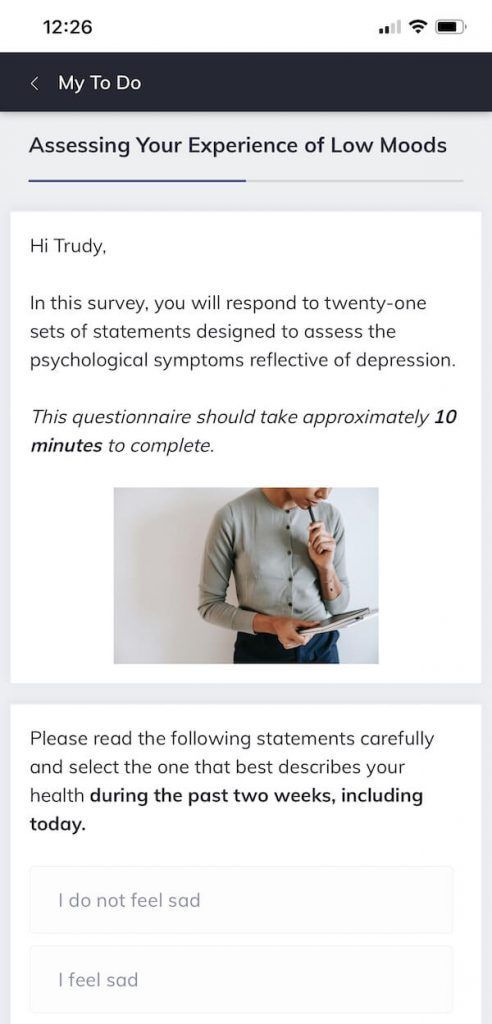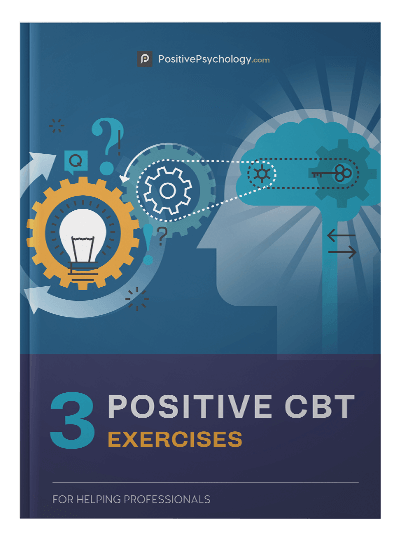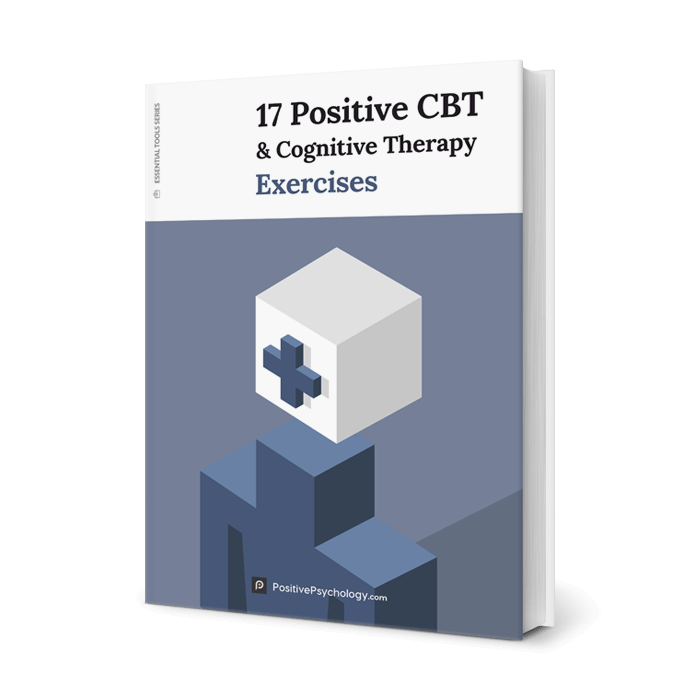Mental Health Treatment Plans: Templates, Goals & Objectives
 Planning – some of us love it, some of us hate it, and some of us just don’t have any idea how to do it!
Planning – some of us love it, some of us hate it, and some of us just don’t have any idea how to do it!
Part of effective mental health treatment is the development of a treatment plan.
A good mental health professional will work collaboratively with the client to construct a treatment plan that has achievable goals that provide the best chances of treatment success.
Read on to learn more about mental health treatment plans, how they are constructed, and how they can help.
Before you continue, we thought you might like to download our three Positive CBT Exercises for free. These science-based exercises will provide you with detailed insight into Positive CBT and give you the tools to apply it in your therapy or coaching.
This Article Contains:
What is a Treatment Plan? A Definition
At the most basic level, a mental health treatment plan is simply a set of written instructions and records relating to the treatment of an ailment or illness. A treatment plan will include the patient or client’s personal information, the diagnosis (or diagnoses, as is often the case with mental illness), a general outline of the treatment prescribed, and space to measure outcomes as the client progresses through treatment.
A treatment plan does many things, the most important of which include (Leahy, Holland, & McGinn, 2011; PHN, 2017):
- Defining the problem or ailment
- Describing the treatment prescribed by the health/mental health professional
- Setting a timeline for treatment progress (whether it’s a vague timeline or includes specific milestones)
- Identifying the major treatment goals
- Noting important milestones and objectives
This documentation of the most important components of treatment helps the therapist and client stay on the same page, provides an opportunity for discussion of the treatment as planned, and can act as a reminder and motivational tool.
A wide range of people can benefit from mental health treatment plans, including:
- People living with a serious mental illness
- People experiencing distress in one or more areas of life
- Children, parents, and/or families
- The elderly
- Individuals
- Couples
- People with developmental disabilities
- People experiencing sexual or gender identity issues
- People being bullied and/or abused
- Bullies and/or abusers
- People in the criminal justice system
- Employers and/or employees (Croft, 2015).
While people in similar circumstances with similar issues may have similar treatment plans, it’s important to understand that each treatment plan is unique.
There are often many different ways to treat the same problem – sometimes there are dozens of different paths that treatment could take!
No two treatment plans will be exactly the same, because no two people’s experiences are exactly the same.
What, Exactly, is in a Treatment Plan?

As noted earlier, all treatment plans are different – they are unique products of the discussions between a therapist and client, the therapist’s clinical knowledge, and the client’s shared experience.
Even in identical diagnoses in similar individuals, differences are bound to manifest in any or all of the following components:
- History and Demographics – client’s psychosocial history, history of the symptoms, any past treatment information.
- Assessment/Diagnosis – the therapist or clinician’s diagnosis of the client’s mental health issues, and any past diagnoses will also be noted.
- Presenting Concerns – the problems or symptoms that initially brought the client in.
- Treatment Contract – the contract between the therapist and client that summarizes the goals of treatment.
- Responsibility – a section on who is responsible for which components of treatment (client will be responsible for many, the therapist for others).
- Strengths – the strengths and resources the client brings to treatment (can include family support, character strengths, material support, etc.).
- Treatment Goals – the “building blocks” of the plan, which should be specific, realistic, customized for the client, and measurable.
- Objectives – goals are the larger, more broad outcomes the therapist and client are working for, while multiple objectives make up each goal; they are small, achievable steps that make up a goal.
- Modality, Frequency, and Targets – different modalities are often applied to different goals, requiring a plan that pairs modalities, a frequency of sessions, anticipated completion date, etc., with the respective goal.
- Interventions – the techniques, exercises, interventions, etc., that will be applied in order to work toward each goal.
- Progress/Outcomes – a good treatment plan must include space for tracking progress towards objectives and goals (Hansen, 1996)
The therapist and client will work together to get this information down on paper, with the therapist contributing his or her expertise in treatments and treatment outcomes, and the client contributing expertise in his or her own life and experiences.
Why Use a Treatment Plan?
Besides the obvious benefits that planning usually brings, there are a few specific advantages that mental health treatment plans impart to those who use them.
These benefits include:
- Treatment plans provide a guide to treatment for both the therapist and client.
- Treatment plans can reduce the risk of fraud, waste, abuse, and the potential to cause unintentional harm to clients.
- Treatment plans facilitate easy and effective billing since all services rendered are documented.
- Treatment plans can help smooth any potential bumps in treatment, especially if a client requires a kind of treatment the primary therapist cannot provide (e.g., a certain type of intervention or a prescription for medication) or must see a new therapist for some other reason (e.g., if the client or therapist has moved, or the therapist is on extended leave, PHN, 2017).
While treatment plans are quite popular in mental health treatment, it should be noted that not every therapist or clinician will use one. Treatment plans are not necessarily required to give or receive successful treatment, but they can be extremely helpful in facilitating a smooth and hassle-free treatment experience.
Goals and Objectives of a Treatment Plan

If you or your client is committed to change but isn’t quite sure where to begin, this link of potential goals can spark a useful discussion about where to go from here.
Goals are the broadest category of achievement that clients in mental health counseling work towards. For instance, a common goal for those struggling with substance abuse may be to quit using their drug of choice or alcohol, while a patient struggling with depression may set a goal to reduce their suicidal thoughts.
In general, these goals should be realistic – they should be reasonable, given the client’s general experience and hopes for the future.
Objectives are basically goals broken into smaller pieces – many similar or subsequent objectives will make up a goal.
For example, an objective for an individual with extreme anxiety may be to take 10 steps outside their front door. The next objective may be to make it to the neighborhood market, or up to 30 steps outside their front door.
Meeting each objective will eventually lead you to meet the goal.
How to Create a Treatment Plan
There are many resources out there on how to create a mental health treatment plan – there’s even a WikiHow page on the subject!
This checklist is an especially good resource for treatment planning, due in part to how brief and to-the-point it is. The checklist breaks down treatment plans into five sections: Problem Statements, Goals, Objectives, Interventions, and General Checklist.
The checklist items are presented by section as follows:
Problem Statements
- Do problem statements reflect the six problem domains?
1 – Medical status
2 – Employment and support
3 – Drug/Alcohol use
4 – Legal status
5 – Family/Social status
6 – Psychiatric status - Are problem statements written in behavioral terms?
- Are problem statements written in a non-judgmental and jargon-free manner?
- Are problem statements based on priority needs?
What does the client want to achieve during treatment?
- Do goals address the problem statements?
- Are the goals attainable during the active treatment phase?
- Would the client be able to understand the goals as written?
- Would both the client and the treatment program find these goals acceptable?
- Has the client’s stage of readiness to change been considered in the goal statements?
Counseling treatment planning – Dr. Todd Grande
Objectives
What will the client say or do? Under what circumstances? How often will he/she say or do this?
- Do objectives address the goals?
- Are the goals SMART?
o Specific – Are specific activities included? Could the client understand what is expected?
o Measurable – Can change or progress toward meeting the objectives be documented/evaluated?
o Attainable – Can the client take steps toward meeting the objectives?
o Realistic – Can the client meet the objectives given their current situation?
o Time-Limited/Timely – Is the time frame specified for the objectives? - Has the client’s stage of readiness to change been considered in the objectives?
Interventions
What will the counselor/staff do to assist the client? Under what circumstances?
- Do interventions address the objectives?
- Are the interventions SMART (Locke & Latham, 1990)?
o Specific – Are specific staff persons responsible for assisting client/providing service?
o Measurable – Will the counselor/treatment program be held accountable for the services?
o Attainable – Do interventions reflect the level of care available or are outside referrals used when needed?
o Realistic – Do the interventions reflect the level of functioning or functional impairment of the client?
o Time-Limited/Timely – Is the time frame specified for the interventions? - Has the client’s stage of readiness to change been considered in the interventions (Rollnick, Heather, Gold, & Hall, 1992)?
General Checklist
- Is this treatment plan individualized to fit the client based on their unique abilities, goals, lifestyle, socio-economic status (SES), work history, educational background, and culture?
- Are the client’s strengths incorporated into the treatment plan?
- Has the client (and significant others) participated in developing this treatment plan?
- Is the plan dated and signed by all who participated in developing this treatment plan?
Not every treatment plan will call for each of these items. This is fine since every treatment plan is as individual as the client treated, but it should be noted why the item does not apply.
When each item is “checked” off the list (or addressed in writing if it is not applicable), the treatment plan is likely a good one – or, at least, it has the basics of a good treatment plan!
If you work with children and would like some tips on preparing a good treatment plan for a young client, check out the Pennsylvania CASSP Training and Technical Assistance Institute’s publication on this subject here.
Technologies to Support Mental Health Treatment Plans (Incl. Quenza)

However, therapists are increasingly leveraging the benefits of technology in creative ways to help develop, execute, and evaluate mental health treatment plans using a blended care approach.
Blended care involves the provision of psychological services using telecommunication technologies.
Among these technologies are many digital platforms that therapists can use to supplement real-time therapy sessions to help accomplish the steps included in mental health treatment plans.
For example, using a blended care platform such as Quenza, a therapist may carry out some of the initial steps in the assessment/diagnosis phase of a treatment plan, such as by inviting the client to complete a digital diagnostic questionnaire.
Likewise, the plan may incorporate various psychoeducational interventions which can be delivered digitally, such as guided meditations, reflection exercises, or self-paced learning modules.
A therapist may even use these tools following the conclusion of a client’s in-person treatment as part of a follow-up, such as to assess whether a client has remained psychologically well a few months down the line or requires additional support.
These are just a few ideas for how you might use a blended care tool such as Quenza to help carry out some steps in a mental health treatment plan.
Examples of Mental Health Treatment Plans

This sample treatment plan is for a young Medicaid recipient struggling with symptoms of depression and suicidal thoughts.
This treatment plan is written for the treatment of a man suffering from schizoaffective disorder who is experiencing side effects from his medication.
If you’d like to see more, this website has a ton of useful example treatment plans and templates.
A Treatment Plan Template
As noted earlier, one template will not cover all of the possibilities for a client’s treatment plan, but this template can at least provide a starting point.
Feel free to rearrange, remove, and add as needed, but make sure to properly cite the source if you use it for profit or publish it somewhere (source information is at the bottom of the template).
A Take-Home Message
In this article, we’ve discussed the purpose and general description of a mental health treatment plan.
We hope you have a better idea of how treatment plans work, why therapists use them, and how they can help individuals struggling with mental health problems.
Have you ever created a mental health treatment plan? Have you ever had a mental health treatment plan created for you? Let us know in the comments!
As always, thank you for reading!
We hope you enjoyed reading this article. For more information, don’t forget to download our three Positive CBT Exercises for free.
- Croft, H. (2015). What is a mental health treatment plan? Why is it important? GoodTherapy. Retrieved from https://www.healthyplace.com/other-info/mental-illness-overview/what-is-a-mental-health-treatment-plan-why-is-it-important/
- Hansen, M. (1996). Writing effective treatment plans: The Pennsylvania CASSP model. Retrieved from http://www.ccbh.com/pdfs/Providers/healthchoices/articles/TreatmentPlans.pdf
- Leahy, R. L., Holland, S. J., & McGinn, L. K. (2011). Treatment plans and interventions for depression and anxiety disorders. New York, NY: Guilford Press.
- Locke, E. A. & Latham, G. P. (1990). A theory of goal setting and task performance. Upper
Saddle River, NJ: Prentice-Hall. - PHN. (2017). Mental health treatment plans: A guide for health professionals working in general or private practice. Retrieved from https://www.nwmh.org.au/sites/default/files/2017-06/Mental%20Health%20Treatment%20Plans%20North%20Western%20Melbourne%20PHN.pdf
- Rollnick, S., Heather, N., Gold, R., & Hall, W. (1992). Development of a short ‘readiness to change’ questionnaire for use in brief, opportunistic interventions among excessive drinkers. British Journal of Addiction, 87(5), 743-754.
Let us know your thoughts
Read other articles by their category
- Body & Brain (49)
- Coaching & Application (57)
- Compassion (26)
- Counseling (51)
- Emotional Intelligence (24)
- Gratitude (18)
- Grief & Bereavement (21)
- Happiness & SWB (40)
- Meaning & Values (26)
- Meditation (20)
- Mindfulness (45)
- Motivation & Goals (45)
- Optimism & Mindset (34)
- Positive CBT (28)
- Positive Communication (20)
- Positive Education (47)
- Positive Emotions (32)
- Positive Leadership (18)
- Positive Parenting (3)
- Positive Psychology (33)
- Positive Workplace (37)
- Productivity (16)
- Relationships (46)
- Resilience & Coping (36)
- Self Awareness (21)
- Self Esteem (37)
- Strengths & Virtues (31)
- Stress & Burnout Prevention (34)
- Theory & Books (46)
- Therapy Exercises (37)
- Types of Therapy (64)





What our readers think
I have been looking how to Create a Treatment Plan, so here are many resources out there on how to create a mental health treatment plan, thanks so much.
Hi, thank you so much for your article. It is clear and very helpful. However, I have some questions related to PSR master treatment plan. Then, PSR groups are based for example MDD diagnosis, different specific problems but the same symptoms. When I do the PSR Master Treatment Plan, the Problem and Long term goal (client’s goal) is specific to each client BUT the objectives and intervention are the same for each participant in that group. I would like to have a consultation if you can help me with this topic. Thank you so much for your support.
Hi Lourdes,
Glad you enjoyed the article. I’m afraid we don’t offer individual consultations. However, if you’re looking for support, perhaps get in touch with the International Board for Certification of Group Psychotherapists, who offer customized training and consultations on these sorts of topics.
– Nicole | Community Manager
Dear Courtney Ackerman,
I am Dr. Ahmer Mehkri, Health Manager in Shell Oil Company – Saudi Arabia.
I have no words to express my feelings about this wonderful article.
Such a great & comprehensive study which explain everything & most important giving utmost importance & feeling of satisfaction to the client (employee).
If you have any updates, please do contact me in my below contact details.
Kind Regards.
I am a grad student studying Marriage and Family Therapy, and I have been looking for models of treatment plans for one of my assignments, and this one will help me in putting it together.
Thanks
Wouh! This item has been a blessing to me
Excellent article.
Thank you for your excellent article.
Thank you for such a comprehensive and well organized article which is especially helpful for those of us new MSWs just going out into the field. A great compact refresher!
Thank you very much, this article was indeed very helpful.
I am just beginning to break new ground in the world of counseling. I am currently pursuing a Masters Degree in Clinical Counseling to become an LPC. I need help!
Thank you so much for sharing such valuable information, it is precisely stated. It’s good to be on such platformshort, it helps in enhancing our skills as mental health service providers. “Learning isome a process” Thank you once again.